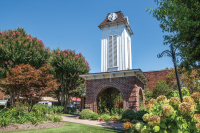The unfriendly skies
I was working in the yard the other afternoon when I heard a crisp “whap!” — like the sound of a line drive in the third baseman’s mitt — just above my head. A pipevine swallowtail butterfly spun to the ground, wings flapping wildly. My first thought was a dragonfly must have made a grab for it. When I reached down to pick it up, I found a bald-faced hornet latched onto its head.
Generally, outside, I let nature take its course. Predator versus prey is simply a part of the mix, but I guess seeing the hornet intent on decapitating the butterfly caused a knee-jerk reaction. I grabbed the butterfly’s wings and shook it and the hornet came loose, but it was back before the pipevine could get airborne. I got a stick and pried the hornet off and pinned it to the ground, and the pipevine took off under its own power.
I knew that some dragonflies — pondhawks, dragon hunters and maybe more — would occasionally take butterflies, but the hornet was a new one for me. It appears that bald-faced hornets are very active predators feeding on a number of insects including crickets, bottle flies, crane flies, grasshoppers, katydids and several species of butterflies such as clouded sulphurs, painted ladies, eastern tiger swallowtails and, of course, pipevine swallowtail.
Legend has it that the bald-faced hornet has such a voracious appetite for flies that pioneers would relocate hornet’s nests near their homes as a means of controlling houseflies.
Bald-faced hornets’ nests are those gray pear-shaped paper nests — nearly invisible in summer — that are seen hanging from bare tree branches in the winter. Which brings us to another point. Bald-faced hornets, Dolichovespula maculata, are not hornets at all. They are paper wasps — a species of yellow jacket.
Those nests are the domains of a single queen. She begins in the spring by chewing up small strips of wood, mixing it with saliva and making a few cells where she deposits eggs. These eggs hatch into larvae that are fed chewed up insects by the queen. The larvae develop into sterile female workers. The workers begin to take over nest building and babysitting, so the queen can get down to serious egg laying. By the end of summer, the nest may be pumpkin-sized and hold 700 or more workers and drones (fertile males, without stingers) and the queen.
Related Items
At the end of the summer, the queen will lay eggs that will become fertile males and females. These will mate. As winter approaches all the hornets die, except the fertile females. These will overwinter and become next year’s queens.
While the bald-faced hornet is an accomplished predator, it is by no means at the top of the food chain. It is preyed on by flycatchers, bats, spiders, dragonflies and mantises. Raccoons, bears, skunks and foxes will destroy nests to feed on the larvae.
Bald-faced hornets are pretty docile and beneficial insects and should be welcomed in your landscape as long as their nests are not in a high traffic area or within reach of a curious toddler. Trust me, 700 angry hornets are a force to be reckoned with.









